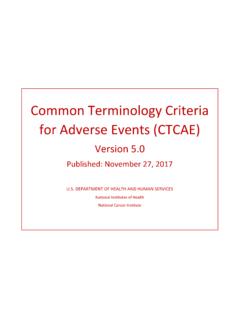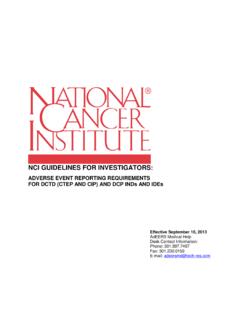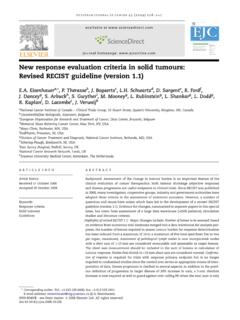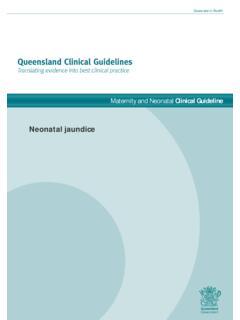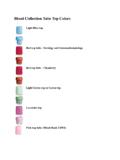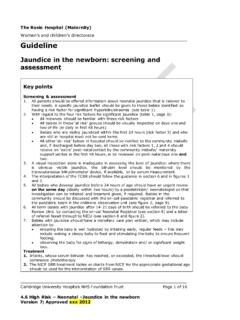Transcription of Common Terminology Criteria for Adverse Events v3.0 (CTCAE)
1 Cancer Therapy Evaluation Program, Common Terminology Criteria for Adverse Events , Version , DCTD, NCI, NIH, DHHS March 31, 2003 ( ), Publish Date: August 9, 2006 Common Terminology Criteria for Adverse Events (CTCAE) Publish Date: August 9, 2006 Quick Reference The NCI Common Terminology Criteria for Adverse Events is a descriptive Terminology which can be utilized for Adverse Event (AE) reporting. A grading (severity) scale is provided for each AE term. Components and Organization CATEGORY A CATEGORY is a broad classification of AEs based on anatomy and/or pathophysiology. Within each CATEGORY, AEs are listed accompanied by their descriptions of severity (Grade). Adverse Event Terms An AE is any unfavorable and unintended sign (including an abnormal laboratory finding), symptom, or disease temporally associated with the use of a medical treatment or procedure that may or may not be considered related to the medical treatment or procedure.
2 An AE is a term that is a unique representation of a specific event used for medical documentation and scientific analyses. Each AE term is mapped to a MedDRA term and code. AEs are listed alphabetically within CATEGORIES. Short AE Name The SHORT NAME column is new and it is used to simplify documentation of AE names on Case Report Forms. Supra-ordinate Terms A supra-ordinate term is located within a CATEGORY and is a grouping term based on disease process, signs, symptoms, or diagnosis. A supra-ordinate term is followed by the word Select and is accompanied by specific AEs that are all related to the supra-ordinate term. Supra-ordinate terms provide clustering and consistent representation of Grade for related AEs.
3 Supra-ordinate terms are not AEs, are not mapped to a MedDRA term and code, cannot be graded and cannot be used for reporting. REMARK A REMARK is a clarification of an AE. ALSO CONSIDER An ALSO CONSIDER indicates additional AEs that are to be graded if they are clinically significant. NAVIGATION NOTE A NAVIGATION NOTE indicates the location of an AE term within the CTCAE document. It lists signs/symptoms alphabetically and the CTCAE term will appear in the same CATEGORY unless the NAVIGATION NOTE states differently. Grades Grade refers to the severity of the AE. The CTCAE displays Grades 1 through 5 with unique clinical descriptions of severity for each AE based on this general guideline: Grade 1 Mild AE Grade 2 Moderate AE Grade 3 Severe AE Grade 4 Life-threatening or disabling AE Grade 5 Death related to AE A Semi-colon indicates or within the description of the grade.
4 An Em dash ( ) indicates a grade not available. Not all Grades are appropriate for all AEs. Therefore, some AEs are listed with fewer than five options for Grade selection. Grade 5 Grade 5 (Death) is not appropriate for some AEs and therefore is not an option. The DEATH CATEGORY is new. Only one Supra-ordinate term is listed in this CATEGORY: Death not associated with CTCAE term Select with 4 AE options: Death NOS; Disease progression NOS; Multi-organ failure; Sudden death. Important: Grade 5 is the only appropriate Grade This AE is to be used in the situation where a death 1. cannot be reported using a CTCAE term associated with Grade 5, or 2. cannot be reported within a CTCAE CATEGORY as Other (Specify) Contents ALLERGY/IMMUNOLOGY.
5 1 2 BLOOD/BONE MARROW .. 4 CARDIAC 5 CARDIAC 7 COAGULATION .. 10 CONSTITUTIONAL 11 13 DERMATOLOGY/SKIN .. 14 ENDOCRINE .. 17 19 GROWTH AND 29 30 HEPATOBILIARY/PANCREAS .. 34 INFECTION .. 35 LYMPHATICS ..38 METABOLIC/LABORATORY ..40 MUSCULOSKELETAL/SOFT TISSUE .. 43 NEUROLOGY .. 47 52 PAIN .. 55 PULMONARY/UPPER 56 60 SECONDARY MALIGNANCY ..63 SEXUAL/REPRODUCTIVE FUNCTION .. 64 SURGERY/INTRA-OPERATIVE 66 SYNDROMES .. 68 70 ALLERGY/IMMUNOLOGY Page 1 of 1 Grade Adverse Event Short Name 1 2 3 4 5 CTCAE - 1 - March 31, 2003, Publish Date: August 9, 2006 Allergic reaction/ hypersensitivity (including drug fever) Allergic reaction Transient flushing or rash; drug fever <38 C (< F) Rash; flushing; urticaria; dyspnea; drug fever 38 C ( F) Symptomatic bronchospasm, with or without urticaria; parenteral medication(s) indicated; allergy-related edema/angioedema; hypotension Anaphylaxis Death REMARK: Urticaria with manifestations of allergic or hypersensitivity reaction is graded as Allergic reaction/hypersensitivity (including drug fever).
6 ALSO CONSIDER: Cytokine release syndrome/acute infusion reaction. Allergic rhinitis (including sneezing, nasal stuffiness, postnasal drip) Rhinitis Mild, intervention not indicated Moderate, intervention indicated REMARK: Rhinitis associated with obstruction or stenosis is graded as Obstruction/stenosis of airway Select in the PULMONARY/UPPER RESPIRATORY CATEGORY. Autoimmune reaction Autoimmune reaction Asymptomatic and serologic or other evidence of autoimmune reaction, with normal organ function and intervention not indicated Evidence of autoimmune reaction involving a non-essential organ or function ( , hypothyroidism) Reversible autoimmune reaction involving function of a major organ or other Adverse event ( , transient colitis or anemia) Autoimmune reaction with life-threatening consequences Death ALSO CONSIDER: Colitis; Hemoglobin; Hemolysis ( , immune hemolytic anemia, drug-related hemolysis); Thyroid function, low (hypothyroidism).
7 Serum sickness Serum sickness Present Death NAVIGATION NOTE: Splenic function is graded in the BLOOD/BONE MARROW CATEGORY. NAVIGATION NOTE: Urticaria as an isolated symptom is graded as Urticaria (hives, welts, wheals) in the DERMATOLOGY/SKIN CATEGORY. Vasculitis Vasculitis Mild, intervention not indicated Symptomatic, non-steroidal medical intervention indicated Steroids indicated Ischemic changes; amputation indicated Death Allergy/Immunology Other (Specify, __) Allergy Other (Specify) Mild Moderate Severe Life-threatening; disabling Death AUDITORY/EAR Page 1 of 2 Grade Adverse Event Short Name 1 2 3 4 5 CTCAE - 2 - March 31, 2003, Publish Date: August 9, 2006 NAVIGATION NOTE: Earache (otalgia) is graded as Pain Select in the PAIN CATEGORY.
8 Hearing: patients with/without baseline audiogram and enrolled in a monitoring program1 Hearing (monitoring program) Threshold shift or loss of 15 25 dB relative to baseline, averaged at 2 or more contiguous test frequencies in at least one ear; or subjective change in the absence of a Grade 1 threshold shift Threshold shift or loss of >25 90 dB, averaged at 2 contiguous test frequencies in at least one ear Adult only: Threshold shift of >25 90 dB, averaged at 3 contiguous test frequencies in at least one ear Pediatric: Hearing loss sufficient to indicate therapeutic intervention, including hearing aids ( , 20 dB bilateral HL in the speech frequencies; 30 dB unilateral HL; and requiring additional speech-language related services) Adult only: Profound bilateral hearing loss (>90 dB) Pediatric: Audiologic indication for cochlear implant and requiring additional speech-language related services REMARK: Pediatric recommendations are identical to those for adults, unless specified.
9 For children and adolescents ( 18 years of age) without a baseline test, pre-exposure/pre-treatment hearing should be considered to be <5 dB loss. Hearing: patients without baseline audiogram and not enrolled in a monitoring program1 Hearing (without monitoring program) Hearing loss not requiring hearing aid or intervention ( , not interfering with ADL) Hearing loss requiring hearing aid or intervention ( , interfering with ADL) Profound bilateral hearing loss (>90 dB) REMARK: Pediatric recommendations are identical to those for adults, unless specified. For children and adolescents ( 18 years of age) without a baseline test, pre-exposure/pre-treatment hearing should be considered to be <5 dB loss. Otitis, external ear (non-infectious) Otitis, external External otitis with erythema or dry desquamation External otitis with moist desquamation, edema, enhanced cerumen or discharge; tympanic membrane perforation; tympanostomy External otitis with mastoiditis; stenosis or osteomyelitis Necrosis of soft tissue or bone Death ALSO CONSIDER: Hearing: patients with/without baseline audiogram and enrolled in a monitoring program1; Hearing: patients without baseline audiogram and not enrolled in a monitoring program1.
10 Otitis, middle ear (non-infectious) Otitis, middle Serous otitis Serous otitis, medical intervention indicated Otitis with discharge; mastoiditis Necrosis of the canal soft tissue or bone Death AUDITORY/EAR Page 2 of 2 Grade Adverse Event Short Name 1 2 3 4 5 CTCAE - 3 - March 31, 2003, Publish Date: August 9, 2006 Tinnitus Tinnitus Tinnitus not interfering with ADL Tinnitus interfering with ADL Disabling ALSO CONSIDER: Hearing: patients with/without baseline audiogram and enrolled in a monitoring program1; Hearing: patients without baseline audiogram and not enrolled in a monitoring program1. Auditory/Ear Other (Specify, __) Auditory/Ear Other (Specify) Mild Moderate Severe Life-threatening; disabling Death 1 Drug-induced ototoxicity should be distinguished from age-related threshold decrements or unrelated cochlear insult.


